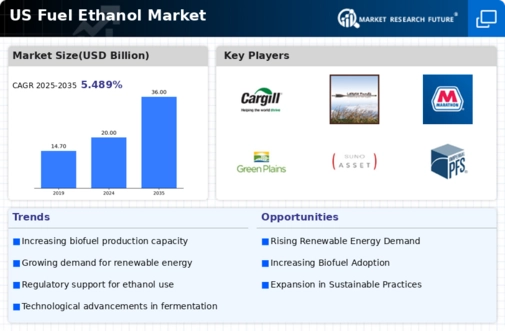The fuel ethanol market in the US is characterized by a dynamic competitive landscape, driven by increasing demand for renewable energy sources and stringent environmental regulations. Key players such as POET LLC (US), Archer Daniels Midland Company (US), and Valero Energy Corporation (US) are at the forefront, each adopting distinct strategies to enhance their market positioning. POET LLC (US) focuses on innovation in production technologies, aiming to improve efficiency and reduce costs, while Archer Daniels Midland Company (US) emphasizes strategic partnerships to expand its supply chain capabilities. Valero Energy Corporation (US) is actively pursuing regional expansion, enhancing its production capacity to meet growing consumer demand. Collectively, these strategies contribute to a competitive environment that is increasingly focused on sustainability and technological advancement.
In terms of business tactics, companies are localizing manufacturing to reduce transportation costs and optimize supply chains. The market structure appears moderately fragmented, with several key players exerting influence over pricing and production standards. This fragmentation allows for a variety of operational strategies, enabling companies to differentiate themselves through localized production and tailored marketing approaches.
In November 2025, Green Plains Inc. (US) announced a significant investment in advanced fermentation technology aimed at increasing ethanol yield from corn. This strategic move is likely to enhance their production efficiency and reduce overall costs, positioning them favorably against competitors. The investment reflects a broader trend within the industry towards technological innovation as a means of achieving competitive advantage.
In October 2025, Cargill Inc. (US) launched a new initiative focused on carbon capture and storage (CCS) at its ethanol production facilities. This initiative not only aligns with global sustainability goals but also positions Cargill as a leader in environmentally responsible production practices. The strategic importance of this move lies in its potential to attract environmentally conscious consumers and investors, thereby enhancing Cargill's market share.
In September 2025, Renewable Energy Group Inc. (US) entered into a partnership with a leading technology firm to develop AI-driven analytics for optimizing ethanol production processes. This collaboration is indicative of a growing trend towards digital transformation within the industry, suggesting that companies are increasingly leveraging technology to enhance operational efficiency and reduce costs. The implications of such partnerships could redefine competitive dynamics, as firms that successfully integrate advanced technologies may gain a substantial edge.
As of December 2025, the competitive trends in the fuel ethanol market are heavily influenced by digitalization, sustainability initiatives, and the integration of AI technologies. Strategic alliances are becoming more prevalent, shaping the landscape as companies seek to enhance their capabilities and market reach. Looking ahead, it appears that competitive differentiation will increasingly pivot from traditional price-based competition to a focus on innovation, technological advancements, and supply chain reliability. This shift may redefine how companies position themselves in the market, emphasizing the importance of sustainable practices and cutting-edge technologies.























Leave a Comment